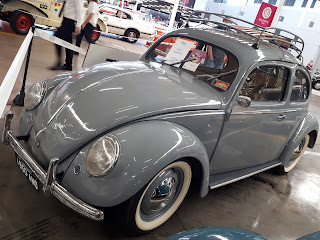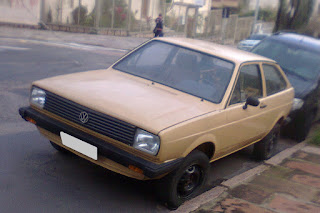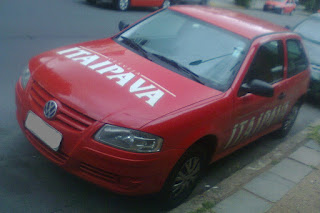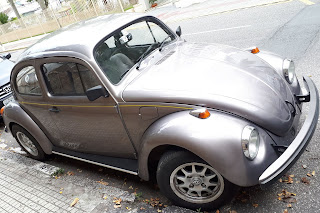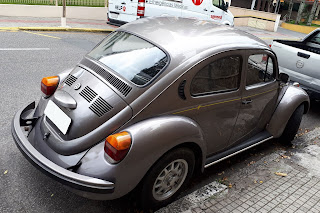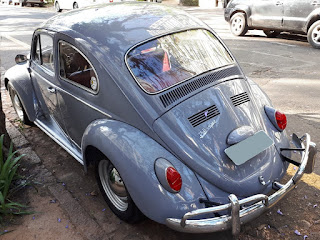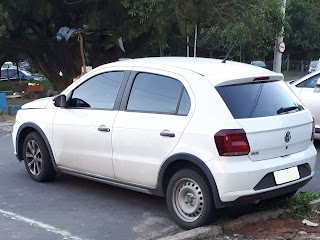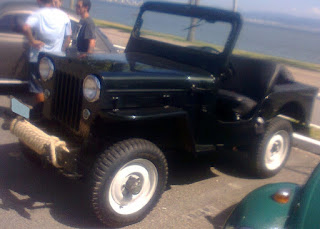Premiered in the Beetle, the Volkswagen air-cooled "boxer" flat-4 engine is definitely a masterpiece of engineering, and expanded into a broad range of automobiles and light-duty commercial vehicles. However, plagued by the seemingly unjustifiable efforts needed to improve its cooling and emissions, such wonderful engine was phased out in 2006. Sure the prevalence of the transverse-engine layout in newer entry-level cars would render it more complicated to fit into a modern econobox, but it's not an excuse to have not extended the
A model which could've benefitted from a longer lifespan for the old flat-4 is the Gol, which actually had a 1.3L version of this engine at its beginning and subsequently 1.6L ones before receiving water-cooled inline-4 MD-270 and EA827 engines until its final longitudinal-engine iterations discontinued in 2013 which already had the EA-111 engine in 1.0L versions and the EA827 in 1.6L ones. Among the reasons for the air-cooled engine to have been still a better fit to the Gol are its smaller weight and shorter overhang, leading to a better weight bias and a lesser effort over the structure. On a sidenote, the lenght of the water-cooled engines required the radiator to be placed behind the left headlight in order to not increase too excessively the front overhang.
Having the engine front-mounted enhanced substantially the cooling in the Gol, which would already be a good reason for the air-cooled flat-4 to fare reasonably, even though water-cooling could be seen as an ultimate response to the increasingly tight emissions control for the Kombi which was the last of all rear-engined traditional Volkswagens having switched to water-cooling between 2006 and 2013 when a flexfuel 1.4L version of the EA-111 became the sole engine available. Even though it would be also challenging to say the least, eventually not being so exaggerated to qualify as an engineering nightmare, keeping the old boxer without significant improvements to the cooling was still evaluated by Volkswagen when Brazil switched from Euro-2 to Euro-3 on utility vehicles. Noise suppression is what actually pulled the plug on the old boxer.
As far as cooling and its side-effects on emissions go, sometimes it's quite surprising Volkswagen has seemingly not considered to apply a technical solution resembling Suzuki's SACS oil-cooling which was featured to some of its GSX motorcycles. Considering it allowed more compact engine castings as fewer cooling fins would be required, which was the main goal of Suzuki with its design aiming to sports motorcycles, even if Volkswagen would rather retain the old castings it's always worth notice a small oil cooler had always been a standard fitment to rear-engined applications of the flat-4, then it's not rocket-science to lurk about an eventual fitment of a larger one with some sort of thermostat for a more accurate control of the oil cooling which could be done either with a bypass valve (which still allows a minimum oil flow through the radiator in order to prevent it to be damaged by any vacuum formation inside its pipes) or some restrictor flaps surrounding the cooler.
The lack of further interest to improve the air-cooled flat-4 might also have something to do with the regulatory conditions in Brazil, where from the Beetle's first phaseout in '86 to a short reintroduction between '93 and '96 and from the Beetle's ultimate phaseout in Brazil to 2006 the Kombi was the only remaining vehicle featuring this engine not counting others from smaller automakers who sourced the engine from Volkswagen. Eventually the commercial failure of a water-cooled EA827 Diesel engine when fitted briefly to the Kombi was a deciding factor for Volkswagen to not apply any other water-cooled engine to this model for a while, and the stiff competition from Asian vans once the Brazilian market was reopened for imports in '90 could have led to its demise, but in '93 then-president Itamar Franco who was an enthusiast of the Beetle arranged for the 1.6L version of the boxer to be included under the same lower taxation scheme implemented for the water-cooled 1.0L engines, which was dropped as soon as the Beetle was phased out one more time in '96 when Fernando Henrique Cardoso was the president. Considering it took a while for Volkswagen to bring its own 1.0L engines to Brazil instead of sourcing them from Ford through the AutoLatina joint-venture which was also phased out in '96, it's quite surprising there was no attempt to apply for the very same benefit to be extended to other models at least as a stop-gap measure, to which eventually the Brazilian market where it's still quite common to point out an engine's displacement as a prestige feature would lead some customers to actually prefer the seemingly-outdated air-cooled boxer over its water-cooled 1.0L contenders.
The perceived resilience of the "Beetle's engine" is still highly praised by enthuiasts, and brings back memories of simpler yet effective engineering solutions pretty much forgotten on light-duty vehicles such as the gear-driven OHV valvetrain which has fewer failure-prone elements due to the absence of a timing belt or chain. In a country where the Beetle is still beloved not only by collectors who live in a big city, being also often regarded as a rural tool, this would be a good-enough argument in favor of this engine. And since water-cooled cars actually resort to anti-freezing fluid mixed with water, it's a matter of concern due to the risk of environmental damage after a cooling fluid leakage near some water course or storm sewers.
Even though most of those traditional buyers of the Gol who look at its utilitarian aspect more than for performance enhancements back in the day of longitudinally-mounted EA827 engines assimilated smoothly the transition to transverse engines started in 2008, since much of its ergonomics are often pointed out to not have departed too much from previous models it's nearly impossible to not wonder how a modern Gol would have been with an improved air-cooled boxer...
Thursday, July 02, 2020
Wednesday, July 01, 2020
What would be my favorite engines to swap into a Jeep CJ-3B?
One of the American-designed vehicles I like the most, with features that contrast with most of those landyacht imagery from the full-size cars of its day, the Jeep CJ-3B has a convenient size which could still render it a good base for a daily-driver project. On the other hand, a stock 2.2L Hurricane F-head gasoline-powered engine was already quite outdated even by then when OHV designs prevailed. The first upgrade I would consider in order to make a CJ-3B a reliable and preferably more fuel-efficient all-around commuter is an engine swap, to which 5 engines could be favored by me.
1 - Perkins 404: available either in naturally-aspirated or turbocharged versions, this Diesel engine could be regarded as a natural evolution considering the usage of the Perkins 4-108 engine in some Spanish versions of the CJ-3B. All the 4-cylinder versions of the 400-series Perkins engines come in the a 2.2L displacement, just like the gasser it would be replacing, and it's also worth to notice the gear-driven OHV valvetrain and injector timing are not so failure-prone, so the maintenance would not be too significantly more complex;
2 - Yanmar 4TNV88: a comparable engine to the Perkins 404, it has been widely fitted not only to stationary/industrial applications and agricultural machinery to be also found on sailboats, to which once again the Perkins 4-108 had been widely used as auxiliary power. Available either with natural aspiration or turbocharging too, this engine has also been used for swaps into compact trucks even in the United States, even though some performance upgrades are frequently added in order to meet the requirements for these rigs which even in stock form are larger and heavier than a CJ-3B;
3 - Chevrolet 153: even though it's also an old gasser just like the Hurricane, the gear-driven OHV valvetrain is an improvement over the precarious intake-over-exhaust approach. This has actually been one of my favorite engines for a long time;
4 - Volkswagen air-cooled flat-4: even though it may seem quite weird, a "Veep" still attracts me. Even though the most usual approach for such swap was to replace the entire frame for a shortened Volkswagen one with a makeshift rear engine compartment, trying to fit the engine upfront would not be discarded immediately;
5 - Hatz 2L41C/2M41: even though a 2-cylinder Diesel engine may not seem so attractive at a first glance, its 1.8L displacement range is once again comparable to the Perkins 4-108, while the air cooling is also quite tempting. A major downside is the weight of those engines, even though the small amount of cylinders may fool someone to believe it would be a hassle-free engine swap...
1 - Perkins 404: available either in naturally-aspirated or turbocharged versions, this Diesel engine could be regarded as a natural evolution considering the usage of the Perkins 4-108 engine in some Spanish versions of the CJ-3B. All the 4-cylinder versions of the 400-series Perkins engines come in the a 2.2L displacement, just like the gasser it would be replacing, and it's also worth to notice the gear-driven OHV valvetrain and injector timing are not so failure-prone, so the maintenance would not be too significantly more complex;
2 - Yanmar 4TNV88: a comparable engine to the Perkins 404, it has been widely fitted not only to stationary/industrial applications and agricultural machinery to be also found on sailboats, to which once again the Perkins 4-108 had been widely used as auxiliary power. Available either with natural aspiration or turbocharging too, this engine has also been used for swaps into compact trucks even in the United States, even though some performance upgrades are frequently added in order to meet the requirements for these rigs which even in stock form are larger and heavier than a CJ-3B;
3 - Chevrolet 153: even though it's also an old gasser just like the Hurricane, the gear-driven OHV valvetrain is an improvement over the precarious intake-over-exhaust approach. This has actually been one of my favorite engines for a long time;
4 - Volkswagen air-cooled flat-4: even though it may seem quite weird, a "Veep" still attracts me. Even though the most usual approach for such swap was to replace the entire frame for a shortened Volkswagen one with a makeshift rear engine compartment, trying to fit the engine upfront would not be discarded immediately;
5 - Hatz 2L41C/2M41: even though a 2-cylinder Diesel engine may not seem so attractive at a first glance, its 1.8L displacement range is once again comparable to the Perkins 4-108, while the air cooling is also quite tempting. A major downside is the weight of those engines, even though the small amount of cylinders may fool someone to believe it would be a hassle-free engine swap...
Subscribe to:
Comments (Atom)
